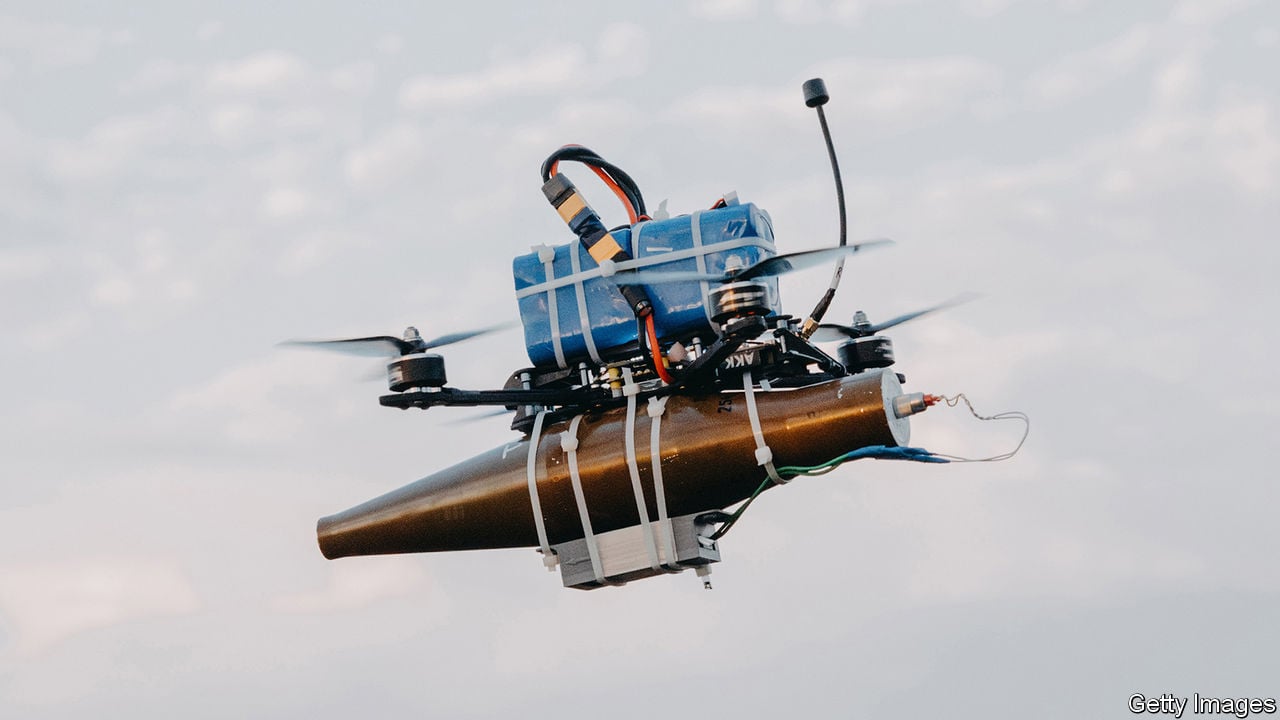What sucks is that us hobbist’s can’t get FPV, motors, ESC’s, or batteries at reasonable prices (if at all)
The reality of it, is this is short lived.
Anti-Air meant for small drones like this is coming and soon.
And it will shut these down quickly.
How would that anti-air against small drones look like? It is not easy.
Probably miniaturized versions of CIWS / C-RAM or laser systems.
Nah, lasers too big. It would be a simple birdshot shotgun. Its detection and aiming.
When they are high up, they can be hard to spot and hear.
But a pair of sensitive mic’s and a camera designed to look for them could easily be paired with some AR glasses.somebody already put lasers on F35 and israelis are using ground-based lasers as a complement to iron dome
Drones currently outpace their countermeasurs. This will definitely not be a thing forever. I think the effectiveness of cheap drones will go down as be countermeasures are invented.
We already see new very effective military drone jammers starting to come out
Onboard AI guidance is not difficult.
Yes it is.
Both of you are right.
It’s difficult, but how difficult depends on the task you set. If the task is “maintain manually initiated target lock on a clearly defined object on an empty field, despite the communications link breaking for 10 seconds” -> it is “give a team of coders half a year” difficult. It’s been solved before, the solution just needs re-inventing and porting to a different platform.
If it’s “identify whether an object is military, whether it is frienly or hostile, consider if it’s worth attacking, and attack a camouflaged target in a dense forest”, then it’s currently not worth trying.
That was a good guess but unfortunately it is just difficult even in the scenario you proposed
The only reliable counter to a drone is likely another drone.
I suspect Peter F Hamilton got it close, in the Confederation series, with WASPs. They are space based weapon platforms. They carry a mix of offensive and defensive subsystems, and operate with swarm logic.
I could easily see a larger drone carrying a swarm of 1 shot micro drones. When close, some would be sacrificed to get better sensor data, others would go on the attack. Conversely, a defensive target would launch their own swarm. It’s goal would be to stop the attackers getting a good shot on a high value target. It might also counterattack, either against the mother ship drone, or backtracking to find the launch site.
Jamming would also be part of this. A jammer could easily cut off the swarm from external data sources. Live satellite or remote surveillance systems would be cut. Point to point lasers are far harder, as are burst transmissions. Local sensor drones could easily punch short range data back, or paint targets, until they are destroyed by defensive systems.
You use the word easily so many times here where it becomes more and more apparent that you probably don’t think it means what it means
I’ve worked with drones of various sizes. Bigger and more expensive ones are more capable, but hard to make bullet proof. If you can remote off their sensors and weapons into cheap, more disposable systems, it makes sense.
A big drone, like a predator, drops a package into an area. Mid sized multicopters provide local computing power and coordination. Small planes provide fast loiter surveillance. Small multicopters with cameras give more accurate coverage. For attack, you have what amounts to a hand grenade with props. Protection takes the form of similar disposables. A flying strobe light to mess up optical tracking. Chaff bombs to mess up radar tracking. Smoke to obscure the high value units.
A lot of these I could throw together myself, given a few weeks, and a few grand. What part wouldn’t be easy, for a large and well funded military r&d team?
What part wouldn’t be easy? The hand grenade with props. The strobe light. The chaff. The software. The batteries and power supply. The reliability. The compute requirements. There is so many things that are easy sounding to you because you romanticise the idea but it’s not easily done at all
Easy for a remotely advanced military force.
An explosive drone is easy. Just a small amount of high explosives and an electronic detonator.
Strobe lights could just be an overdriven LED. It just needs to dazzle optical sensors for a few seconds.
Chaff is just lightweight foil. It’s effectively an oversized party popper. It’s job is to help overwhelm radar based tracking.
Software is the hardest bit. At the same time, many computer game ‘AIs’ are good enough at this they need to be dumbed down significantly. It would be more specialised, but only needs to be written once, then rolled out to a fleet.
Batteries would be a swarms limiting factor. Single shot lithium would likely be the bulk. 5-20 minutes of flight, then it’s dead. Disposables would likely need to be moved into position by other means, either a dedicated transport drone, ground transport, or air drop. Your transport doesn’t need to stay in the combat zone however, it can bug out and be reused. Larger more specialist systems would land and loiter to save batteries, and/or be fuel cell powered.
Reliability is handled by numbers, losing 10% is fine, when you have 20% extra.
Computing requires would be met by something like Nvidia’s Jetson range. They are designed for low power, low weight AI processing. Putting a tflop of computing power in the close Comms loop would be simple. The controller would be the most expensive part of the swarm. Not only would it need enough power, both computing and electrical, but also significant Comms capabilities. Radio links, with optical backup would be the workhorse. With a mesh setup, including dummies to help hide it’s location. This is similar to how the display drones work. An expensive hub, serving a cheap swarm.
While none of this is “easy” for a random guy in a shed, or a terrorist in a cave, it’s child’s play compared to a lot of the tech the US can deploy.
It’s not easy for you, me
For anyone.
It’s easy for the anime engineers in your head
No, it’s not just arts and crafts foil put in a box and now you have chaffe
Again it’s just you romanticised the idea and don’t understand how complicated such a system would be, it’s beyond our capabilities to make
military hardware is not made to be cool, it’s made to be cost effective and reliable
I design build and operate broadcast equipment. A good chunk goes onto UAVs. I’ve built small quads, and I’ve played around with equipment fully capable of some of the more complex tasks. E.g. live 3D mapping from an airborne capable computer.
I’m also friends with several people who used to design and build military equipment, including radar systems. Military tech is a weird mix of amazingly high tech, stupidly simple hacks and long lifespan versions of off the shelf technology. I’ve a fairly good feel for how hard or easy a good chunk of the bits are to build. Most of what I suggested I could personally design and build, or easily commission, given some time, a reasonable budget, and access to restricted resources as required.
In its simplest form, chaff is just tuned lengths of mylar foil. As it flutters, it glitters in a radar beam. This creates a large noise floor. While modern military chaff is more advanced, the old stuff will still cause problems for modern systems. It’s not trying to hide a tank, or pull off a missile’s lock. It’s trying to swamp the signal from a tiny, mostly plastic, drone.
I’m also not saying to reinvent the wheel. Chaff is now a fairly niche defence tool. It’s hard to use while advancing, and gives away your position. It also needs to be integrated with other countermeasures to be useful. It is still a fairly solved problem however. It’s cheap to make, quick to deploy, and available in bulk, if required.
Most modern military equipment isn’t expensive due to its inherent nature. It’s expensive because it’s a niche product, and the buyers have deep wallets. The same game plays out in broadcasting. A £100k camera isn’t that much better than a £5k one. It is better however, and buyers are willing to pay for that difference.
The reverse is also true, as Ukraine is proving. 100 $1k drones are more useful than 1 $100k, ultra capable, drone or missile. The point of a swarm is to allow multiple cheap systems to do the job of a far more expensive weapon.



